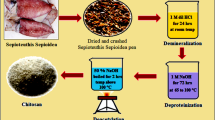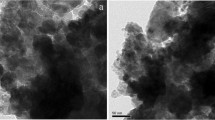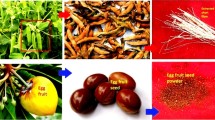Abstract
This study explored the effectiveness of hardened epoxy containing pear cactus fiber and onion sheath biocarbon nanosheet. Mechanical, dielectric, and thermal properties of pear cactus epoxy composites containing varying volumes of biocarbon nanosheet are the focus of this investigation. For this study, biocarbon was extracted by pyrolysis from red onion peel. For 3 vol.% of biocarbon, tensile strength was up to 63%, and flexural strength was up to 44% higher than pure epoxy. The addition of reinforcements boosted the Izod impact toughness and hardness values by around 5 volume percent to roughly 94% and 92%, respectively. When biocarbon made up 5% of a material’s volume, improvements in dielectric constant and loss were around 5.8 and 0.23, respectively. The inclusion of biocarbon increased the thermal conductivity to a high of 0.44 W/mK. These composites might be used as a shielding material because to their improved dielectric, mechanical, and thermal activities.








Similar content being viewed by others
Data availability
All data are within the manuscript.
References
Alshahrani H, Arun Prakash VR (2022) J Clean Prod 133931. https://doi.org/10.1016/j.jclepro.2022.133931
Muthu SS, Li Y, Hu JY et al (2012) Carbon footprint reduction in the textile process chain: recycling of textile materials. Fibers Polym 13:1065–1070. https://doi.org/10.1007/s12221-012-1065-0
Ben Samuel J et al (2021) Silicon 13:1703–1712. https://doi.org/10.1007/s12633-020-00569-0
Arun Prakash VR, Xavier JF, Ramesh G et al (2020) Biomass Conv Bioref. https://doi.org/10.1007/s13399-020-00938-0
Arun KK et al (2022) Silicon 14:6837–6845. https://doi.org/10.1007/s12633-021-01456-y
Merneedi A et al (2021) Experimental investigation on mechanical properties of carbon nanotube-reinforced epoxy composites for automobile application. J Nanomater 2021
Ramaswamy R et al (2022) P Polym Compos 43(8):4899. https://doi.org/10.1002/pc.26735
Kumar S et al (2022) Polym Compos 1. https://doi.org/10.1002/pc.26761
Mohan Prasad M et al (2022) Biomass Conv Bioref. https://doi.org/10.1007/s13399-021-02154-w
Castellano J et al (2021) Opuntia spp. fibre characterisation to obtain sustainable materials in the composites field. Polymers 13(13):2085
Arun Prakash VR, Viswanathan R (2019) Int J Plast Technol 23:207–217. https://doi.org/10.1007/s12588-019-09251-6
Jayabalakrishnan D, Saravanan K, Ravi S et al (2021) Silicon 13:2509–2517. https://doi.org/10.1007/s12633-020-00612-0
Prabhakar MN, Shah AUR, Rao KC et al (2015) Fibers Polym 16:1119–1124. https://doi.org/10.1007/s12221-015-1119-1
Suthan R et al (2021) Silicon 13:1199–1207. https://doi.org/10.1007/s12633-020-00508-z
Alshahrani H, Arun Prakash VR (2022) Prog Org Coat 172:107080. https://doi.org/10.1016/j.porgcoat.2022.107080
Alshahrani H, Prakash VRA (2022) Biomass Conv Bioref. https://doi.org/10.1007/s13399-022-02801-w
Mayer JA, Cushman JC (2019) Nutritional and mineral content of prickly pear cactus: a highly water‐use efficient forage, fodder and food species. J Agron Crop Sci 205(6):625–634
Prabhu P et al (2022) Biomass Conv Bioref. https://doi.org/10.1007/s13399-021-02177-3
Rajadurai A (2016) Appl Surf Sci 384:99-106. https://doi.org/10.1016/j.apsusc.2016.04.185
Prakash VRA, Viswanthan R (2019) Compos Part A Appl Sci Manuf 118:317–326. https://doi.org/10.1016/j.compositesa.2019.01.008
Rajadurai A (2017) Def Technol 13(1):40-46. https://doi.org/10.1016/j.dt.2016.11.004
Jayabalakrishnan D et al (2021) Polym Compos. https://doi.org/10.1002/pc.26393
Merizgui T et al (2021) J Magn Magn Mater 536:168118. https://doi.org/10.1016/j.jmmm.2021.168118
Merizgui T et al (2019) Mater Res Express 6(4):046102. https://doi.org/10.1088/2053-1591/aaf9de
Balaji N et al (2022) Biomass Conv Bioref. https://doi.org/10.1007/s13399-022-02650-7
Mohana Krishnudu D et al (2022) J Nat Fibers 19(1):339-348. https://doi.org/10.1080/15440478.2020.1745115
Bhaskar KB, Santhanam V, Devaraju A (2020) Dielectric strength analysis of acacia nilotica with chemically treated sisal fiber reinforced polyester composite. Dig J Nanomater Biostructures 15(1):107–113
Mohamed RM, Suhaimi UA (2021) The properties of coconut coir fiber reinforced epoxy composites. Int J Synergy Eng Technol 2(1):103–108
Bhagat et al (2014) Polym Compos 35 (5):925–930. https://doi.org/10.1016/j.jcis.2017.01.105
Srivastava A, Madhusoodan M (2015) Int J Res EngTechnol 4 (04):2395-0056
Jayamani E et al (2014) Comparative study of dielectric properties of hybrid natural fiber composites. Procedia Eng 97:536–544
Ridzuan MJM et al (2020) Effect of natural filler loading, multi-walled carbon nanotubes (MWCNTs), and moisture absorption on the dielectric constant of natural filled epoxy composites. Mater Sci Eng B 262:114744
Dhal JP, Mishra SC (2013) Processing and properties of natural fiber-reinforced polymer composite. J Mater 2013
Xia C, Garcia A, Shi S et al (2016) Hybrid boron nitride-natural fiber composites for enhanced thermal conductivity. Sci Rep 6:34726. https://doi.org/10.1038/srep34726
Biswas S et al (2015) Physical, mechanical and thermal properties of jute and bamboo fiber reinforced unidirectional epoxy composites. Procedia Eng 105:933–939
Dinesh T, Kadirvel A, Vincent (2019) Silicon 11:2487–2498. https://doi.org/10.1007/s12633-018-9886-0
Arun Prakash VR, Rajadurai A (2016) Appl Phys A 122 875. https://doi.org/10.1007/s00339-016-0411-2
Author information
Authors and Affiliations
Contributions
Ramaswamy R—concept and research work.
Kaliappan S—facilitation and concept of research work.
Natrayan L—concept and research work.
Pravin P Patil—concept and research work.
Corresponding author
Ethics declarations
Ethical approval
NA.
Code of ethics
NA.
Conflict of interests
The authors declare no competing interest.
Additional information
Publisher's note
Springer Nature remains neutral with regard to jurisdictional claims in published maps and institutional affiliations.
Rights and permissions
Springer Nature or its licensor holds exclusive rights to this article under a publishing agreement with the author(s) or other rightsholder(s); author self-archiving of the accepted manuscript version of this article is solely governed by the terms of such publishing agreement and applicable law.
About this article
Cite this article
R, R., S, K., L, N. et al. Pear cactus fiber with onion sheath biocarbon nanosheet toughened epoxy composite: mechanical, thermal, and electrical properties. Biomass Conv. Bioref. 14, 9077–9085 (2024). https://doi.org/10.1007/s13399-022-03335-x
Received:
Revised:
Accepted:
Published:
Issue Date:
DOI: https://doi.org/10.1007/s13399-022-03335-x




